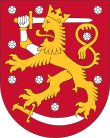
Back المحكمة العليا الفنلندية Arabic Oberstes Gericht (Finnland) German Korkein oikeus (Suomi) Finnish Cour suprême de Finlande French בית המשפט העליון (פינלנד) HE Corte suprema (Finlandia) Italian Korkein oikeus NB Högsta domstolen (Finland) Swedish 芬兰最高法院 Chinese
| Supreme Court of Finland | |
|---|---|
| Korkein oikeus - Högsta domstolen | |
 The Court House of the Supreme Court | |
 | |
| Jurisdiction | Finland |
| Location | Helsinki |
| Composition method | Appointed by the President of Finland |
| Authorised by | Constitution of Finland |
| Appeals from | Courts of Appeal |
| Number of positions | At least 15 |
| Annual budget | 8,96 million € (2022)[1] |
| Website | The homepage of the Supreme Court of Finland |
| President | |
| Currently | Tatu Leppänen[2] |
| Since | 1 September 2019 |
 |
|---|
The Supreme Court of Finland (Finnish: korkein oikeus [ˈkorkei̯n ˈoi̯keus], abbreviated as KKO; Swedish: högsta domstolen, abbreviated as HD), located in Helsinki, is the court of last resort for cases within the private law of Finland (that is, civil and criminal cases). The Court's counterpart is the Supreme Administrative Court, which is the court of last resort for cases within the administrative law.[3][4][5]
The Supreme Court consists of a President and at minimum 15, currently 18, other Justices, usually working in five-judge panels. The most important function of the Supreme Court is to rule on important points of law in cases which are significant for the entire legal order, guiding the administering of justice in future cases. Decisions of the Courts of Appeal (Finnish: hovioikeudet, Swedish: hovrätter), as well as certain decisions of the Insurance Court may be appealed against to the Supreme Court, provided that it grants leave to appeal. In the rare criminal cases where a Court of Appeal acts as the court of first instance, the leave to appeal is not needed.[a][6]
The Supreme Court may annul final decisions of courts on the grounds provided in Chapter 31 of the Code of Judicial Procedure. The Court also handles complaints concerning errors in procedure. In some cases the Court may restore the right of appeal after the expiration of a specified period of time.
The Supreme Court gives advice to the President in cases concerning the right to grant a pardon, and to the Ministry of Justice in cases concerning extradition. It may provide legal opinions on Government Bills at different stages of the legislative process, and the President may consult it on Bills passed by Parliament before ratifying them. The Supreme Court may also approach the President on its own initiative, and propose enactment of a new Parliament Act or an amendment to an existing Act.[7]
The Supreme Court mainly relies on written evidence when deciding on a case. The Court may, however, hold oral hearings in which the parties, witnesses and experts are heard in person. The oral hearings are public.
- ^ "Korkeimman oikeuden toimintamenot" (PDF). vm.fi. Retrieved 2022-06-14.
- ^ "Members and staff". korkeinoikeus.fi. Retrieved 2019-10-28.
- ^ "Functions of the Supreme Court". korkeinoikeus.fi. Retrieved 8 November 2020.
- ^ "History of the Supreme Court". korkeinoikeus.fi. Retrieved 8 November 2020.
- ^ "Premises". korkeinoikeus.fi. Retrieved 8 November 2020.
- ^ "Functions of the Supreme Court". korkeinoikeus.fi. Retrieved 8 November 2020.
- ^ "Functions of the Supreme Court". korkeinoikeus.fi. Retrieved 8 November 2020.
Cite error: There are <ref group=lower-alpha> tags or {{efn}} templates on this page, but the references will not show without a {{reflist|group=lower-alpha}} template or {{notelist}} template (see the help page).